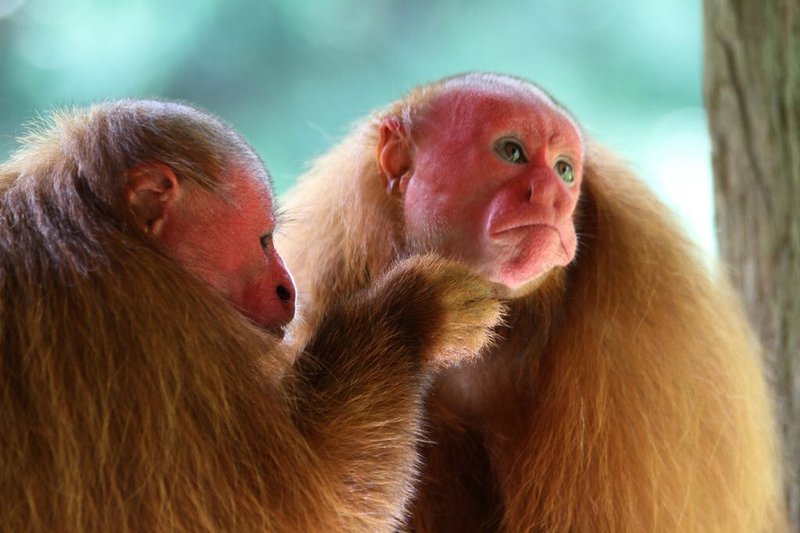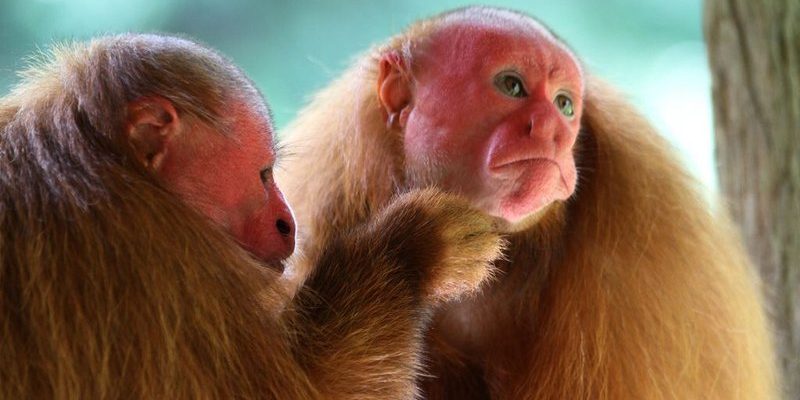
Let’s dive into some fascinating animals that resemble the Uakari in various ways. From their habitats to their distinctive physical traits, we’ll explore how to tell these creatures apart. It’s like playing a visual game of “spot the difference,” but with wildlife. You might even discover some new favorites along the way!
1. Howler Monkey
Howler monkeys are often the loudest animals in the rainforest, known for their distinct calls that can be heard from miles away. Like the Uakari, they live in the trees, often in family groups. What sets them apart, though, is their unique howl that echoes through their lush surroundings.
You might notice that howler monkeys have a longer tail and a more pronounced body compared to the Uakari. Their fur can vary—some are black, while others sport shades of brown. The difference in their facial structure is also significant; Howler monkeys have a more elongated face, while the Uakari’s face is much shorter, with those iconic red hues.
2. Titi Monkey
Titi monkeys are another lively species found in South America. They’re social creatures, often spotted cuddling with their mates. With their small, compact bodies, Titi monkeys resemble the Uakari at first glance. However, their fur is usually a mix of brown and grey, with a bushy tail that’s not as stumpy as the Uakari’s.
What really distinguishes them is their behavior. Titi monkeys are known for their strong pair bonds, often seen with their tails entwined. If you’re looking closely, you’ll also spot their bigger, rounder eyes compared to the Uakari’s more almond-shaped ones.
3. Capuchin Monkey
Capuchins are some of the most intelligent monkeys out there. They have expressive faces and are quick learners, often seen using tools in their daily lives. They’re medium-sized like Uakaris, but their coloring is quite different, typically featuring a mix of black and white fur. Their iconic faces have a slightly more curious expression.
Telling Capuchins apart from Uakaris is easy if you focus on their tails. Unlike the Uakari’s short tail, Capuchins have long, prehensile tails that help them navigate their forest homes. Plus, they’re more versatile with their diet, munching on fruits, insects, and sometimes even small animals.
4. Squirrel Monkey
Squirrel monkeys are lively little creatures that love to leap around the trees. Their small size and playful nature might remind you of the Uakari, but here’s the thing: they have much thinner limbs and a slender build. Their fur is usually a bright yellow or golden color, which contrasts sharply with the reddish tone of the Uakari’s face.
One of the main differences lies in their group dynamics. Squirrel monkeys often form larger social groups, sometimes numbering up to 100 individuals! So, if you see a bustling troop in the treetops, it’s likely to be squirrel monkeys rather than Uakaris, who tend to form smaller bands.
5. Spider Monkey
With their long limbs and tails, spider monkeys are quite the acrobats of the jungle. They share the Uakari’s habitat but stand out because of their distinctive look. Spider monkeys have a much longer body and limbs, giving them an elegant, spider-like appearance when they swing through the trees.
Their tails are not just long; they’re also prehensile, which helps them grab onto branches and swing from tree to tree. Although they don’t have the same vibrant facial features as the Uakari, their large eyes and expressive faces can easily capture your attention.
6. Owl Monkey
Owl monkeys are unique because they’re one of the few nocturnal monkeys. They have a similar body size to the Uakari, but their big, round eyes and softer fur set them apart. Their faces tend to be more round, and they have a distinctive mask-like pattern around their eyes.
You might find an owl monkey snuggling up to its mate at night, looking quite different from the daytime-active Uakari. Their nocturnal habits mean they have different social structures and routine, making it easy to identify them if you know what to look for.
7. Golden Lion Tamarin
The Golden Lion Tamarin, with its striking golden-orange fur and mane-like facial hair, is one of the most visually stunning monkeys out there. They inhabit the same general region as the Uakari, but their appearance is quite different—making them easy to tell apart.
While Uakaris have those famed red faces, Golden Lion Tamarins have vibrant golden fur all over, which gives them a majestic look. Additionally, they tend to be smaller in size, and their social structures differ; these tamarins often live in extended family groups, enhancing their vibrant and lively culture.
8. Marmoset
Marmosets are tiny, bushy-tailed primates that can sometimes confuse folks with their size and social nature. They have a more delicate build compared to the Uakari and sport a variety of colors, including grey, brown, and white. Their distinctively fluffy fur and expressive faces are quite endearing.
One of the biggest differences is their size. Marmosets are significantly smaller, often weighing less than a pound! Their social behavior is also different; they tend to communicate using a series of chirps and squeaks, much different than the Uakari’s vocalizations.
9. Woolly Monkey
Woolly monkeys, as their name suggests, have thick fur giving them a woolly appearance. They are larger than Uakaris, often weighing up to 50 pounds, which makes them the gentle giants of the monkey world. Their long limbs and large, expressive faces set them apart, showcasing a more robust build.
Woolly monkeys usually live in groups and prefer lower tree branches compared to the Uakari’s treetop lifestyle. This difference in habitat is important—if you see a larger monkey lower in the trees, chances are it’s a woolly monkey rather than a Uakari.
10. Bolivian Red Howler Monkey
Finally, the Bolivian red howler monkey shares the Uakari’s vibrant hues, making it another close relative. However, their notable size and the loud howls they produce create a clear distinction. Unlike the Uakari, they boast a larger body size and a longer, more powerful tail.
The most defining characteristic is their vocalization. If you hear a deep, rumbling sound echoing through the forest, it’s probably the Bolivian red howler. They have a unique social structure that involves fewer individuals, making their calls even more memorable.
In summary, while many animals resemble the Uakari in one way or another, each has its unique features and behaviors. Understanding these differences can deepen your appreciation for the incredible diversity of wildlife in the Amazon rainforest. Whether you’re watching them in documentaries or planning a trip to their habitats, knowing what to look for will make your experience even richer. So, the next time someone mentions Uakaris, you’ll have a whole array of fascinating animals to share!

